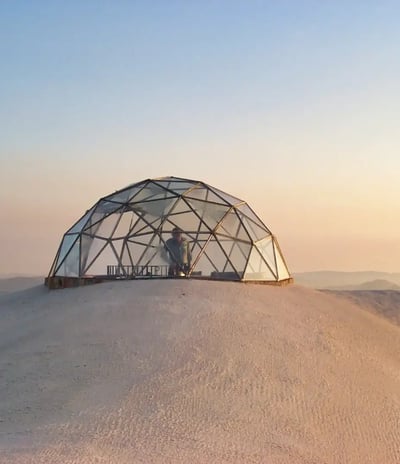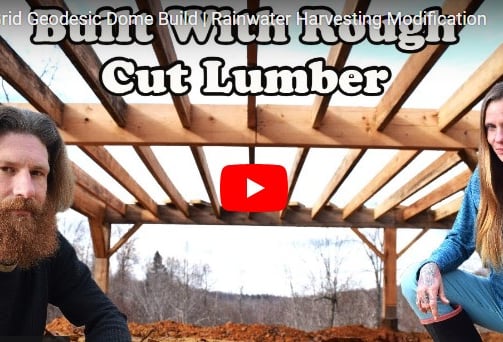Check out our Dome Houses Video Blog here
The Ultimate Guide to Dome Homes: A Sustainable Off-Grid Housing Solution
When considering off-grid living, one housing option stands out for its sustainability, efficiency, and durability: dome homes. With their unique shape and incredible benefits, dome homes are gaining popularity among those looking to live closer to nature while minimizing their environmental footprint. In this guide, we’ll explore everything you need to know about dome homes, from their design to their advantages, and why they’re a perfect fit for off-grid living.




What Are Dome Homes?
Dome homes are structures built with a spherical or hemispherical shape, often resembling a geodesic dome. They are typically constructed using eco-friendly materials like earth, concrete, or lightweight geodesic panels. Their unique architectural design allows for exceptional strength, energy efficiency, and versatility.
These homes are perfect for off-grid living because they can be tailored to function independently from traditional utilities, relying instead on renewable energy, passive heating and cooling, and sustainable materials.
Benefits of Dome Homes
Energy Efficiency
The curved design of dome homes helps reduce energy costs. With no corners, air circulates more efficiently, reducing the need for heating and cooling systems. Many dome homeowners integrate solar panels and passive solar design to maximize energy savings.Eco-Friendly Construction
Dome homes can be built using sustainable materials such as earthbags, hempcrete, or recycled concrete, reducing the carbon footprint associated with traditional housing.Disaster Resilience
Thanks to their aerodynamic shape, dome homes are resistant to extreme weather conditions, including hurricanes, earthquakes, and heavy snow. Their structure distributes stress evenly, making them one of the most durable housing options.Cost-Effective
Dome homes often cost less to build and maintain than traditional homes. Their design requires fewer materials, and their durability ensures lower long-term repair costs.Customizable Design
Dome homes can be tailored to suit any lifestyle. Whether you need multiple rooms, open spaces, or a combination of both, dome homes offer flexible floor plans to match your vision.
How Dome Homes Support Off-Grid Living
Living off-grid often means minimizing your reliance on external utilities. Dome homes naturally align with this philosophy by offering:
Rainwater Harvesting: The rounded roof design makes collecting rainwater simple and effective.
Passive Solar Heating: The structure captures and retains sunlight, keeping the home warm in winter and cool in summer.
Renewable Energy Options: Their shape makes it easy to integrate solar panels, wind turbines, or other renewable energy systems.
Natural Insulation: Many dome homes use earth-based walls or other insulating materials to regulate internal temperatures naturally.
Types of Dome Homes
Geodesic Domes
These are built from interlocking triangular panels, creating a strong, lightweight, and futuristic structure. They are perfect for those prioritizing eco-friendly materials and modern designs.Monolithic Domes
Constructed using a single, solid material like concrete, these domes are highly durable and offer excellent insulation.Earth Domes
Made from natural materials such as rammed earth or earthbags, these domes are incredibly sustainable and integrate seamlessly with the environment.Prefab Dome Kits
Many companies now offer prefabricated dome kits, allowing you to assemble your home quickly without requiring specialized construction skills.
Are Dome Homes Right for You?
If you value sustainability, energy efficiency, and resilience, a dome home may be the ideal choice for your off-grid lifestyle. However, it's essential to consider:
Initial Cost: While dome homes are cost-effective long-term, the upfront costs for certain designs (like prefab kits) can be higher than traditional homes.
Location: Dome homes require careful site planning to optimize passive solar design and ensure proper drainage.
Permits: Some areas may have zoning restrictions or require special permits for alternative housing.
Inspiring Examples of Dome Homes
Desert Domes: Built to withstand the arid heat, these homes use reflective materials and passive cooling.
Tropical Domes: Designed with ventilation systems to keep the home cool in humid climates.
Snow Domes: With insulated walls and efficient heating, these domes thrive in colder regions.
How to Build or Buy a Dome Home
Hire a Professional
Many architects specialize in dome home design. Hiring an expert ensures your home meets structural and environmental standards.DIY Options
Prefab kits make it possible to build your own dome home with minimal construction experience. Companies like Pacific Domes and DomeGaia offer customizable kits.Choose the Right Materials
Research materials that suit your climate and sustainability goals. Earthbags and hempcrete are popular for their low environmental impact.
Final Thoughts on Dome Homes
Dome homes represent more than just a housing option—they are a lifestyle choice. They symbolize a commitment to sustainability, efficiency, and living in harmony with nature. As you embark on your off-grid journey, a dome home could provide the perfect balance of comfort, durability, and eco-friendliness.
Dome Homes
Explore sustainable living with innovative dome home designs.
Dome house Built with Rough Cut Lumber
In our detailed blog post, we dive into:
What makes dome homes so energy-efficient
The different types of dome homes, including geodesic, monolithic, and earth domes
How dome homes are perfect for off-grid living, with passive solar heating, rainwater harvesting, and renewable energy integration
Inspiring examples of dome homes and how to get started with your own!
Check out the full post to explore why dome homes are becoming a top choice for eco-conscious homeowners:



